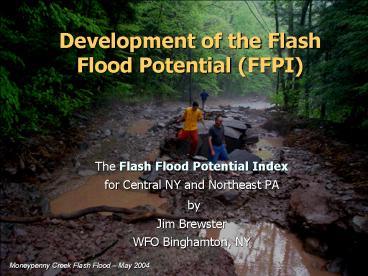Development of the Flash Flood Potential (FFPI) - PowerPoint PPT Presentation
Title:
Development of the Flash Flood Potential (FFPI)
Description:
Development of the Flash Flood Potential (FFPI) The Flash Flood Potential Index for Central NY and Northeast PA by Jim Brewster WFO Binghamton, NY – PowerPoint PPT presentation
Number of Views:151
Avg rating:3.0/5.0
Title: Development of the Flash Flood Potential (FFPI)
1
Development of the Flash Flood Potential (FFPI)
- The Flash Flood Potential Index
- for Central NY and Northeast PA
- by
- Jim Brewster
- WFO Binghamton, NY
Moneypenny Creek Flash Flood May 2004
2
Background
- Flooding is WFO Binghamtons 1 High Impact
Hazard - Central NY and Northeast PA have highly variable
geography, land cover and use. - Steep, rocky terrain along with flatter sandy
plains - Areas of urbanization
- Wide range of forest cover
- Similar soil types
- Experienced forecasters understand some areas are
more prone to flash flooding than others. - But, Where and to what extent?
3
Flash Flood Potential Index (FFPI)
- Developed by hydrologist Greg Smith, CBRFC
(2003). - He understood that geographical features play a
key role in flash flooding. - Developed as background information to be
incorporated into production of better gridded
Flash Flood Guidance - Using the FFPI, the roles of land, vegetation and
urbanization in flash flooding are visualized. - Guesswork to the flash flood problem is reduced
4
Methodology for creating FFPI
- Collected available geographic data sets
- Using GIS
- Projected datum to Albers Equal Area
- Re-sampled data sets to 90 meter resolution
- Reclassified data to a standard index
- Mathematically develop a new geographic index
gridthe FFPI
5
The Data
- Four geographic data sets
- Slope derived from the USGS DEM (Digital
Elevation Model) - MLRC Land Use/Land Cover Grid
- AVHRR Forest Density Grid
- STATSGO Soil Type Classification
6
Slope Index
- Exponentially scaled from 1-10
- USGS engineering studies
- 30 slope is rated strong-very strong slope.
- Approx 20o angle.
- Indexed gt30 as 10.
7
Indexed Land Use/Land Cover
- Much of region shares a similar index
- Mixed forest grassland.
- Mild-Moderate effect on hydrology
- Swamp/water 1-2
- Urban areas 8-10
8
Indexed Forest Density
- High density forest areas are given a low
potential flood index. - Higher uptake rate of moisture
- Low density areas are given high potential index.
- Lower uptake rate of moisture
9
Indexed Soil Texture Class
Class FFPI
1 Sand 2
2 Loamy Sand 4
3 Sandy Loam 3
4 - Silty Loam 4
5 Silt 5
6 Loam 6
7 Sandy Clay Loam 7
8 Silty Clay Loam 7
9 Clay Loam 8
10 Sandy Clay 7
11 Silty Clay 8
12 Clay 9
13 Organic Matter 5
14 Bedrock 10
10
Methodology Review
- Weight average the geographic layers.
- FFPI (1.5Slope LC Soils Forest)N
- Local adjustment to calculation
- Reviewed against historical events
- Flash flooding occurs in our forested areas.
- Is that element really much of an influence here?
- FFPI (1.5Slope LC Soils 0.5Forest)/N
- Raw grid is then zonally averaged into the FFMP
basins.
11
- 90 Meter Resolution
- Warm colors High Potential
- Cool colors Low Potential
12
FFPI mapped to FFMP Basins
- Fit our conceptual flash flood model.
- New realizations, especially the areas of low FF
potential. - Differentiates the best of the worst basins in
an area generally known for high flash flood
potential.
13
FFPI Versatility
- Flexible Formatting
- ESRI Shape file
- KML/KMZ
- GeoTif
- Google Earth
- BMP
- GRx Analyst
14
Case Example
15
Fatal Gorge Flood
16
Storm Total Precipitation
17
(No Transcript)
18
90 m High Resolution
High resolution GIS imagery of FFPI can be useful
to customers and partners for identifying local,
potential flood problem areas that may not be
already known.
19
Summary
- The FFPI was developed in Binghamton due to the
important need to have a static geophysical
reference grid which better illustrates how local
earth system features contribute to flash
flooding. - The FFPI is best used operationally when mapped
to the AWIPS FFMP basins for comparison with
other flash flood tools and techniques. - Through GIS technology, the index could be
developed by any local office. - Note The original developer has a project
underway with Office of Hydrology to further
develop and expand the FFPI nationally.
20
Questions ?
First Year Performance
- Reduced false alarms
- Two warnings - Pike County, PA and Oneida County,
NY were not issued. Follow-up confirmed no
flooding - Increased Lead Time
- Boosted forecaster confidence that additional
rain would lead to flash flooding (Warn on
Forecast) Major flash flooding resulted in
Delaware County, NY































